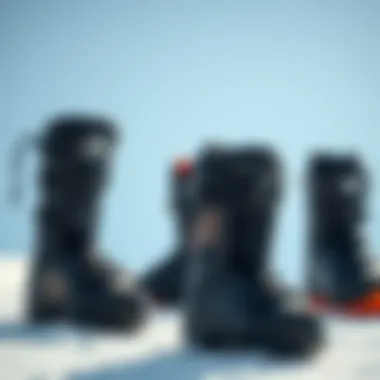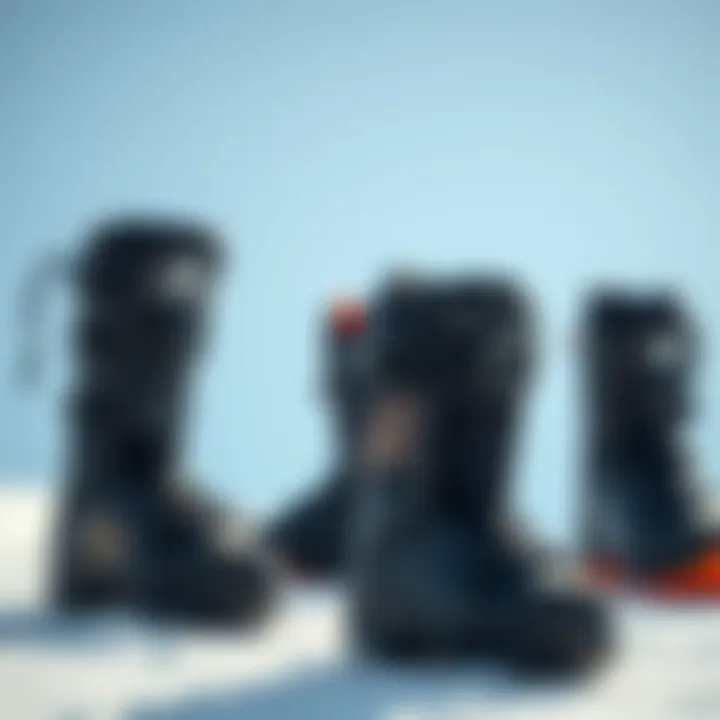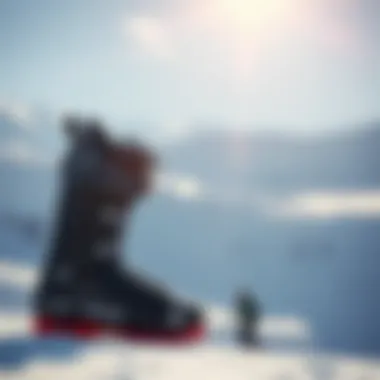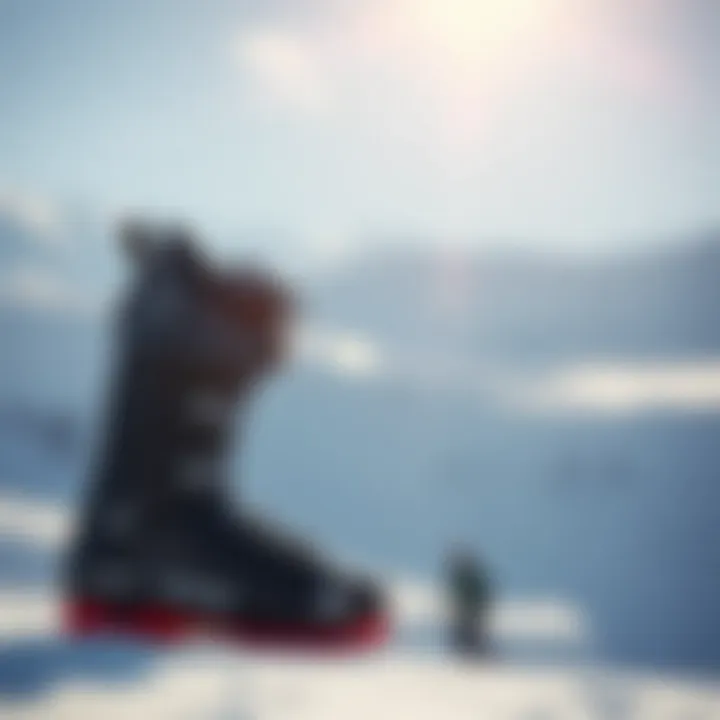The Ultimate Guide to Choosing Snowboard Boots


Intro
Snowboarding is a thrilling endeavor they can generate a mix of adrenaline and pure joy. It’s not simply about gliding down snow-draped slopes, but also about the gear that ensures every ride is both safe and enjoyable. Among the cockpit of equipment you need, snowboard boots play a pivotal role. They can mean the difference between a ride that's a total blast and one that's full of discomfort or even injury.
This guide takes a deep dive into the remarkable world of snowboard boots. It looks into their types, features, and the materials used in construction—all while addressing what to consider before you make that all-important purchase. Getting the right boots can elevate your experience on the mountain, making every turn and jump feel effortless.
Also, we'll peek into maintenance tips, trends swirling about in the snowboard market, and the very innovations that propel the sport forward. Useful for novice snowboarders or seasoned shredders, this narrative flows with insights and practical guidance to enhance your snowboarding escapades.
Understanding Snowboard Boots
Snowboard boots are crucial for anyone hitting the slopes. The right pair not only ensures comfort but also significantly impacts your performance while riding. These boots serve as the direct link between you and your snowboard, making it essential to know what they bring to the table.
The importance of understanding snowboard boots lies in the interplay of fit, design, and functionality. A well-fitting boot can mean the difference between a day filled with joy on the mountain and one riddled with frustration from cold or sore feet. Thus, it's vital to recognize the nuances that distinguish one type from another, catering to a spectrum of riding styles and skill levels.
Moreover, as snowboarding has become a staple in winter sports, the manufacturing process has witnessed remarkable advancements. These advancements have led to a variety of options tailored for different activities—be it freestyle, all-mountain, or backcountry riding. Knowing these specifics not only guides buyers but also helps them to make informed choices, allowing them to align their gear with their riding ambitions.
The Role of Snowboard Boots
Snowboard boots do more than simply keep your feet warm; they play a pivotal role in steering, balance, and shock absorption. Just imagine carving down a powder-filled slope; your boots facilitate the power transfer from your legs to the board. This makes it easier to control your movements, pivoting and steering as needed. A well-designed boot can greatly enhance your ability to respond to changes in the board’s angle and orientation.
In addition, they are engineered to absorb impacts, shielding your feet and ankles from harsh landings. The materials and construction characteristics can influence how much of that energy gets transmitted back to your body.
Types of Snowboard Boots
Snowboard boots fall under three main categories, each tailored to fit various styles of riding and preferences.
Soft Boots
Soft boots are the most commonly used type among snowboarders, especially in freestyle and all-mountain riding. The key characteristic of soft boots is their flexibility, allowing for greater freedom of movement. This flexibility is beneficial when executing tricks or navigating varied terrain. One unique aspect of soft boots is the plush liner, which provides comfort and warmth while catering to the foot's natural shape.
However, while they offer excellent maneuverability, soft boots may not provide the same level of support or responsiveness as stiffer alternatives. This could be a consideration for those engaging in more aggressive riding or speed-oriented descents.
Hardshell Boots
Hardshell boots, as the name suggests, are built with a rigid outer shell that offers increased support and responsiveness. This solid construction is ideal for advanced riders seeking precision in their movements. The primary advantage of hardshell boots lies in their ability to transfer energy effectively, allowing for sharp, aggressive turns.
Nonetheless, rigidity comes at the cost of mobility. They can feel bulky and, in turn, limit some of the fluid movement that many riders prefer. Hardshell boots are often favored by racers and those who prioritize performance over comfort.
Hybrid Boots
Bridging the gap between soft and hardshell, hybrid boots incorporate features from both types, making them versatile for various riding styles. The hybrid design offers a balance of flexibility and firmness, catering to an array of snowboarders. They often include a softer cuff for easier movement paired with a stiffer base for enhanced control. This combination allows riders to enjoy the freedom felt in soft boots while benefiting from the support inherent in hardshell designs.
However, the complexity of these boots can sometimes lead to a slightly higher price point. For those who ride frequently and appreciate customizable features, hybrid boots are often viewed as a savvy investment.
Key Features to Consider
In the realm of snowboarding, choosing the right boots can make the difference between a thrilling ride and a day cut short by discomfort. Understanding key features in snowboard boots is crucial for enhancing performance and ensuring rider confidence on the slopes. Factors like flex ratings, lacing systems, insulation, and materials can significantly affect how well a boot performs under various conditions. By focusing on these elements, you can tailor your choice to match your snowboarding style and ensure you're well-equipped for any kind of adventure.
Flex Ratings Explained
Boot flex ratings are a pivotal consideration when selecting snowboard boots. The flex of a boot refers to its stiffness, which impacts performance and control. Boots with a softer flex are more forgiving and easier for beginners, providing ample comfort for those still mastering their techniques. Conversely, stiffer boots are geared for advanced riders, offering superior support and responsiveness during aggressive turns or jumps. Typically, flex ratings will range from soft (1-3), medium (4-7), to stiff (8-10), and knowing where you stand on that spectrum can aid in making an informed decision.
Lacing Systems Overview
The method of lacing can import a significant effect on how snugly a boot fits and how easily it can be adjusted on the go. Lacing systems fall into three main categories: traditional laces, speed laces, and the Boa system.
Traditional Laces


Traditional lacing offers a classic approach to boot fitting. The primary benefit here is versatility; you can adjust the tightness at different points of the boot according to your personal preference, allowing for customized comfort. Moreover, traditional laces are generally easy to replace if they wear out, which might not be the case with other systems. However, they can sometimes loosen during rides, requiring periodic adjustment. For many, this old-school method remains a reliable choice.
Speed Laces
Speed laces take convenience up a notch. With a one-pull mechanism, they allow for a snug fit from the get-go. This is especially handy for riders who appreciate getting in and out of their boots quickly, which can be a real time-saver on chilly mornings. While they are easy to use, speed laces may not allow as fine-tuned of adjustments as traditional methods do. Riders who value rapid transitions without sacrificing much on fit tend to gravitate toward this option.
Boa System
The Boa system represents a modern solution to lacing woes. Featuring a dial that tightens a system of cables, it gives you the ability to achieve a uniform fit with just a twist. This design not only improves convenience but also enables fast adjustments even while riding, which can be invaluable in certain situations. Admittedly, one downside is that if the system malfunctions, it can be trickier to fix compared to laces. Still, for those who prize efficiency and ease of use, the Boa system is often seen as an attractive option.
Insulation and Liner Materials
The material inside your boots can determine not only comfort but also warmth during chilly days on the mountain. A variety of insulation and liner options exist, with the most common being thermal liners, memory foam, and heat-moldable liners.
Thermal Liners
Thermal liners excel at retaining heat, providing warmth in even the coldest conditions. They're designed to trap warmth while wicking away moisture, keeping your feet dry and toasty for hours. Common among resort riders, these liners emphasize comfort and offer good insulation. However, they may sacrifice some overall responsiveness compared to stiffer liners. Those who prioritize warmth often find thermal liners invaluable.
Memory Foam
Memory foam liners are all about comfort. They adapt to the shape of your foot, giving a snug fit, thus minimizing pressure points. Great for casual riders or those with irregular foot shapes, they offer enhanced comfort but may not deliver the precise response that aggressive riders need. For individuals who enjoy leisurely rides or seek the ultimate in comfort, memory foam presents a favorable choice.
Heat-Moldable Liners
Heat-moldable liners take customization to the next level. When exposed to heat, these liners conform to the specifics of your feet, providing a tailored fit that can boost both comfort and control. The downside, however, is that this process requires access to heat and can limit reusability with different boot shapes. For those seeking optimal performance and are willing to invest time into their gear, heat-moldable liners are favorable.
Sizing and Fit Considerations
When it comes to snowboarding, your equipment is as essential as your skills. Among the various gear, snowboard boots stand out not just for their ability to keep your feet warm, but for the role they play in overall performance. Having the right fit can improve comfort, enhance responsiveness, and reduce the risk of injury. Thus, understanding how to size and fit your snowboard boots properly is critical.
Measuring for the Perfect Fit
Finding the perfect fit for your snowboard boots is akin to finding a needle in a haystack. Not every pair of boots is made the same way, and foot shapes vary widely between riders. To measure for the right fit, consider these steps:
- Use the right tools: Grab a ruler or a measuring tape and ideally a piece of paper to trace your foot outline.
- Stand up straight: Place your foot on the piece of paper, ensuring you’re standing as you would while snowboarding.
- Mark your foot's length and width: Make note of your longest toe to the heel and the widest part of your foot.
- Check different brands: Every brand has its own sizing chart. Compare your measurements to multiple brands as it can be like comparing apples to oranges.
- Try them on: If possible, try several pairs while wearing the socks you plan to wear snowboarding.
A snug fit is essential, but remember, you don’t want them so tight that they cut off circulation. The perfect fit will provide support and responsiveness during your ride.
Common Fit Issues
Even with the best measurement practices, common fit issues can still arise with snowboard boots. Addressing these concerns is necessary to enhance your riding experience. The three main fitting issues include:
Toe Box Space
Toe box space is the area inside the boot that accommodates your toes. A well-fitted toe box allows your toes to wiggle slightly without cramping.
- Key characteristic: The proper toe box space prevents your toes from constantly hitting the ends of the boot, which can lead to discomfort.
- Beneficial choice: A little extra space is essential for circulation, especially on long days on the slopes. This small allowance can make a big difference in your ride in terms of both comfort and performance.
- Unique feature: Various brands have different toe box designs. Some might have a more elongated shape, while others are rounder. Knowing the structure that fits your foot shape well is crucial. Inadequately sizing or an ill-fitted toe box can lead to numbness or pain, which can derail a day of snowy fun.
Heel Lift
Heel lift is another common problem among snowboarders, causing your heel to lift inside the boot while you ride. This can significantly hinder your control on the board.
- Key characteristic: An ideal fit will hug your heel in place firmly but not painfully.
- Beneficial choice: A reduced heel lift means better connection to your board as you turn and maneuver.
- Unique feature: Some boots come with built-in heel lock features or adjustable lacing systems that help minimize lift. Keep in mind that if you have significant heel lift, it can lead to blisters and fatigue, not to mention it decreases performance.
Width Considerations
Width is another critical factor to keep in mind. Some riders have wide feet, while others have slimmer feet. Not all boots accommodate different widths equally.
- Key characteristic: A boot that’s too narrow could constrict your foot, while one that’s too wide will allow for shifting and lack of control.
- Beneficial choice: Getting a boot that fits your width comfortably will ensure that your foot stays connected to the board.
- Unique feature: Manufacturers often provide wide or narrow models for their boots, which can be a game-changer depending on your foot structure. Ideally, your foot should hold snugly without pressure points. When your width fits just right, it allows for better edge control and improved balance.


"A good fitting snowboard boot can turn a day of struggling with right turns into a seamless glide down the mountain."
Ultimately, understanding the nuances of sizing and fit will significantly impact your snowboarding experience. Every bit of attention given here pays off when you’re out there carving through fresh powder.
Performance Features
Performance features in snowboard boots are not just gimmicks; they are essential components that can significantly affect how a rider performs on the slopes. Understanding these features can lead to better choices, ultimately impacting the riding experience and enjoyment. Elements like boot stiffness, support, and responsiveness play crucial roles in how well a rider navigates through different terrains and conditions.
Impact of Boot Stiffness
Boot stiffness is a fundamental characteristic that influences overall riding performance. A stiffer boot generally provides better control, especially on hard-packed snow or while navigating steep descents. For those who prefer speed and aggressive turns, a stiffer boot is like a trusted companion, offering precision. However, it's not one-size-fits-all – softer boots might appeal to those enjoying mellow rides or park sessions. They give more comfort and flexibility, making it easier to tweak tricks or enjoy a leisurely ride down the slope.
Riders often find themselves choosing stiffness based on their riding style. For example, a backcountry rider could benefit from the strength of a stiffer boot, as it offers enhanced support for those undulating terrains. Conversely, freestyle riders who enjoy jumping and tricks may lean towards softer boots for greater maneuverability.
"Choosing the correct boot stiffness can be the difference between a thrilling ride and a challenging one. Find your sweet spot for the best experience!"
A simple guide to boot stiffness levels:
- Soft Boots: Generally rated lower (1-3), providing maximum comfort and flexibility.
- Medium Boots: Offer a balance (4-6), suitable for all-mountain riding.
- Stiff Boots: Rated higher (7-10), perfect for aggressive riding and big turns.
Support and Responsiveness
Support and responsiveness in snowboard boots define how well a boot commands your movements on the board. Good support means proper alignment of the ankle and foot, which is critical when hurtling down a slope. Also, a responsive boot allows for immediate reactions to input, which can be vital when navigating obstacles or making quick adjustments.
The fit of the boot is essential here. A snug, supportive fit reduces movement inside the boot, translating into responsive action. Boots with enhanced ankle support can significantly reduce fatigue and injury risk, especially in dynamic riding situations.
Here are some aspects to consider for improving support and responsiveness:
- Liner Quality: High-quality liners not only keep your feet warm but also contribute to a snug fit that enhances responsiveness.
- Footbed Technology: Custom footbeds can help maintain proper foot alignment and arch support, improving control over the board.
- Calf Support: A boot that offers solid calf support can prevent fatigue, allowing for longer and more enjoyable rides.
Maintenance and Care
When it comes to getting the most out of your snowboard boots, maintenance and care are often overlooked. However, a little attention can make a world of difference in performance and longevity. Proper care not only enhances comfort and responsiveness, but it can also save you from expensive replacement costs down the line. After all, a solid pair of boots is an investment, and like all investments, it pays to protect them.
Cleaning Your Boots
Cleaning your snowboard boots might seem like a chore, but it's essential for their upkeep. Dirt, snow, and moisture can accumulate over time, leading to unpleasant odors and even potential damage.
Steps to Clean Your Boots:
- Remove the Liners: Gently take out the liners to allow thorough cleaning of the outer shell.
- Brush Off Debris: Use a soft brush or cloth to remove any dirt and snow residue from the exterior.
- Use Mild Soap: Mix some mild soap with warm water and use a cloth to wipe the outer surfaces. Be cautious with any harsh chemicals that might degrade materials.
- Rinse Thoroughly: Ensure there's no soap left behind, as it can damage the boot's materials.
- Dry Properly: Avoid direct sunlight. Instead, let them air dry in a well-ventilated area.
Regular cleaning keeps your boots looking fresh and performing at their best. Moreover, it can help catch early signs of wear and tear before they escalate into bigger problems.
Storing Your Boots
When the snow melts, and it’s time to put your gear away, proper storage of your snowboard boots can be just as important as how you clean them. The way you store your boots can have lasting effects on their shape and function for your next season.
Storage Tips:
- Keep Them Dry: Ensuring that both the interior and exterior are completely dry before storage is crucial to prevent mold and unpleasant smells. If your boots have been in a wet setup, hang them upside down to allow moisture to escape.
- Avoid Compression: Never store your boots with pressure applied on them, such as other gear stacked on top. This can break down the liners and affect the fit.
- Use Boot Trees: Consider using boot trees or stuff them with newspaper to help them maintain their shape.
- Store at Room Temperature: Keep them in a temperature-controlled environment; avoid damp basements or hot attics that can warp the materials over time.
Proper storage habits not only preserve the integrity of your snowboard boots but also ensure they’re ready to perform when the next winter hits.
"Taking care of your snowboard boots goes beyond just a few wipes. It's about extending the life of your investment and ensuring every ride is nothing short of exhilarating."
Buying Guide


Navigating the world of snowboard boots can feel a bit like standing at the base of a steep slope—exciting but daunting. This buying guide aims to unravel the complexities of selecting the right boots for your needs. Whether you are a rookie hitting the slopes for the first time, or an experienced rider looking for a performance upgrade, understanding the buying process is vital to enhancing your overall snowboarding experience. Not only does the right boot contribute to your performance but also significantly affects comfort and safety.
Owning a good pair of snowboard boots could mean the difference between a glorious day of shredding powder and a miserable trek back to the lodge. That's why it's crucial to explore essential elements such as where to buy, evaluate the merits of online vs. in-store purchases, and grasp the finer details of sales and discounts. Each of these factors plays an intricate role in securing the best gear at a price that won’t break the bank.
Where to Buy Snowboard Boots
When it comes to sourcing snowboard boots, your choices can range from specialized sports retailers to online giants. Physical stores provide a unique advantage: you can try on various brands and styles, feel the fit, and discuss options with knowledgeable staff. This tactile approach is particularly significant for snowboard boots, which need to hug your feet just right.
Conversely, online shops are a treasure trove of options. Sites like Amazon or Evo offer a wider selection not bound by local inventory. Furthermore, many online retailers provide customer reviews, helping you tap into the experiences of fellow riders. However, the drawback here is the inability to try before you buy, which can lead to potential sizing missteps.
Here are some places to consider for buying snowboard boots:
- Local Snow Sports Shops: Great for personalized advice and testing boots on-site.
- Sporting Goods Chains: Generally carry a range of brands for all levels of experience.
- Online Retailers: Options such as Backcountry, Snowboards.com, and REI for extensive selections.
Each of these venues has its own pros and cons, which you should weigh based on your comfort with sizing and brand preferences.
Evaluating Online vs. In-Store Purchases
The decision between purchasing snowboard boots online or in a store often boils down to personal preference and comfort with technology. In-store purchases give you the advantage of fitting your boots correctly, checking out the boot's quality, and having instant access to knowledgeable staff who can guide you based on your skill level and specific needs. There’s something to be said for that old-school experience of actually being able to try on the boots, feel them around your ankles, and walk around a bit to ensure they fit comfortably.
On the flip side, online purchases often come with competitive pricing, broad selections, and the ability to read feedback from other customers. Plus, you can easily compare prices across different sites. However, buying footwear without trying them on can sometimes lead to misalignment with your size or fit preferences, resulting in an unwelcome surprise when unboxing at home.
To navigate this choice:
- If you need expert advice: Visit a physical store.
- If convenience and variety are priorities: Online shopping might be the way to go.
Ultimately, embracing both worlds—seeing the product in person but purchasing it online—could be a balanced strategy, especially if you find a model in-store that you love.
Understanding Sales and Discounts
In the world of extreme sports, like snowboarding, availing discounts can significantly ease the financial burden. The smart shopper pays attention not just to the retail price but also to seasonal sales and clearance events. Out-of-season sales often yield significant savings, making it an opportune time to grab a good deal.
Here are a few strategies to capitalize on discounts:
- Sign Up for Newsletters: Many retailers send out exclusive deals and early access to sales for subscribers.
- Follow Retailers on Social Media: Promotions are often announced via social channels, sometimes even offering flash sales.
- Timing the Seasons: Aim to shop off-peak, like purchasing summer gear in the fall, where snowboards and accessories typically see steep discounts.
"The best time to buy snowboarding gear is in the off-season, often providing prices that won't make your wallet weep."
Keep in mind that while discounts can be enticing, still prioritize quality and fit—after all, even a discounted boot that doesn’t fit well can lead to a harsh day on the slopes. A well-fitting boot that supports your adventurous spirit is worth the investment, whether it’s full price or on sale.
In summary, armed with the insights within this buying guide, you will be well-prepared to make an informed decision on your next pair of snowboard boots, enhancing your safety and performance on the mountain. The right pair is out there waiting for you, so take your time and ensure it’s the perfect match.
Current Market Trends
As the world of snowboarding evolves, the landscape of snowboard boots is undergoing significant changes. Understanding these current market trends is crucial for both seasoned riders and newcomers alike. With technology advancing at a rapid pace and environmental concerns gaining traction, awareness of what's happening in the industry can assist enthusiasts in making the best choices for their adventures on snow.
Innovation in Snowboard Boot Technology
In today’s market, innovation is at the heart of snowboard boot technology. We’re seeing boots that offer features designed to enhance performance, comfort, and safety. For instance, manufacturers are now incorporating lightweight materials that provide strength without weighing the rider down. This is particularly important for those tackling backcountry terrains where every ounce counts.
New lacing systems are also making waves. Brands are favoring quick-release mechanisms, giving the riders the ability to tighten or loosen their boots faster and easier, allowing for seamless adjustments throughout the day. The Boa System, for example, has gained popularity due to its one-handed tightening feature, enabling riders to make precise adjustments without bending down or stopping their momentum.
The thermal liners in some models are designed to mold to the shape of the foot with the body heat, providing a custom fit that enhances comfort. This technology not only improves the fit but also retains warmth, keeping feet toasty in freezing temperatures. This melding of technology and performance places the avid snowboarder at the forefront of their game.
Sustainability in Snowboard Manufacturing
With environmental issues taking center stage, sustainability is no longer an optional add-on; it has become a business imperative. More brands are now focusing on eco-friendly practices, from the materials used to the processes they follow. Natural and recycled materials are increasingly finding their way into snowboard boots. For instance, certain companies are experimenting with bio-based plastics that reduce reliance on fossil fuels, appealing to consumers who prioritize sustainability.
In addition, brands are implementing ethical manufacturing practices, ensuring fair labor conditions across their supply chains. This conscientious effort gives buyers an opportunity to support brands that align with their own values on environmental impact. Furthermore, sustainability isn’t just a buzzword; it resonates with thrill-seekers who want to ensure they are protecting the slopes they cherish.
These trends reflect a broader awakening within the snowboarding community regarding responsible consumption. By paying attention to innovation and sustainability, buyers can make an informed decision not only about the gear they choose but also about the larger impact they have on the planet and the sport they love.
"Investing in sustainable gear is investing in the future of our sport. We have a responsibility to preserve the mountains for generations to come."
By understanding these trends, snowboarders can better navigate the offerings available on the market, ensuring their choices enhance both their rides and the environment.







